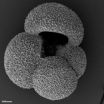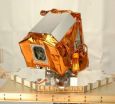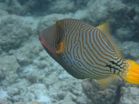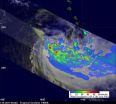(Press-News.org) Eating blueberries can guard against high blood pressure, according to new research by the University of East Anglia (UEA) and Harvard University.
High blood pressure – or hypertension – is one of the major cardiovascular diseases worldwide. It leads to stroke and heart disease and costs more than $300 billion each year. Around a quarter of
the adult population is affected globally – including 10 million people in the UK and one in three US adults.
Published next month in the American Journal of Clinical Nutrition, the new findings show that bioactive compounds in blueberries called anthocyanins offer protection against hypertension. Compared with those who do not eat blueberries, those eating at least one serving a week reduce their risk of developing the condition by 10 per cent.
Anthocyanins belong to the bioactive family of compounds called flavonoids and are found in high amounts in blackcurrants, raspberries, aubergines, blood orange juice and blueberries. Other flavonoids are found in many fruits, vegetables, grains and herbs. The flavonoids present in tea, fruit juice, red wine and dark chocolate are already known to reduce the risk of cardiovascular disease.
This is the first large study to investigate the effect of different flavonoids on hypertension.
The team of UEA and Harvard scientists studied 134,000 women and 47,000 men from the Harvard established cohorts, the Nurses' Health Study and the Health Professionals Follow-up Study over a period of 14 years. None of the participants had hypertension at the start of the study. Subjects were asked to complete health questionnaires every two years and their dietary intake was assessed every four years. Incidence of newly diagnosed hypertension during the 14-year period was then related to consumption of various different flavonoids.
During the study, 35,000 participants developed hypertension. Dietary information identified tea as the main contributor of flavonoids, with apples, orange juice, blueberries, red wine, and strawberries also providing important amounts. When the researchers looked at the relation between individual subclasses of flavonoids and hypertension, they found that participants consuming the highest amounts of anthocyanins (found mainly in blueberries and strawberries in this US-based population) were eight per cent less likely to be diagnosed with hypertension than those consuming the lowest amounts. The effect was even stronger in participants under 60.
The effect was strongest for blueberry rather than strawberry consumption. Compared to people who ate no blueberries, those eating at least one serving of blueberries per week were 10 per cent less likely to become hypertensive.
"Our findings are exciting and suggest that an achievable dietary intake of anthocyanins may contribute to the prevention of hypertension," said lead author Prof Aedin Cassidy of the Department of Nutrition at UEA's Medical School.
"Anthocyanins are readily incorporated into the diet as they are present in many commonly consumed foods. Blueberries were the richest source in this particular study as they are frequently consumed in the US. Other rich sources of anthocyanins in the UK include blackcurrants, blood oranges, aubergines and raspberries."
The next stage of the research will be to conduct randomised controlled trials with different dietary sources of anthocyanins to define the optimal dose and sources for hypertension prevention. This will enable the development of targeted public health recommendations on how to reduce blood pressure.
INFORMATION:
'Habitual intake of flavonoid subclasses and incident hypertension in adults' by A Cassidy (UEA), E O'Reilly (Harvard), Colin Kay (UEA), L Sampson (Harvard), M Franz (Harvard), J Forman (Harvard), G Curhan (Harvard), and E Rimm (Harvard) will be published in the February 2011 edition of the American Journal of Clinical Nutrition.
Bioactive compounds in berries can reduce high blood pressure
2011-01-15
ELSE PRESS RELEASES FROM THIS DATE:
Dramatic ocean circulation changes revealed
2011-01-15
The unusually cold weather this winter has been caused by a change in the winds.
Instead of the typical westerly winds warmed by Atlantic surface ocean currents, cold northerly Arctic winds are influencing much of Europe.
However, scientists have long suspected that far more severe and longer-lasting cold intervals have been caused by changes to the circulation of the warm Atlantic ocean currents themselves.
Now new research led by Cardiff University, with scientists in the UK and US, reveals that these ocean circulation changes may have been more dramatic than ...
Interactive window shopping
2011-01-15
A woman passing by the window display is captivated and asks her companion "Isn't the leather bag chic?" "Which one do you mean? There are so many of them." The woman points to one of the bags and as if by magic the luxurious purse appears on a display behind the shop window. Then she points to a button and the designer object rotates on the screen. "So that's what it looks like from the back." The woman passing by is impressed. She makes another gesture to zoom the bag towards her letting her to see every detail.
This particular shopping experience is courtesy of new ...
Measles virus plays role in Paget's disease of bone, Pitt-led team says
2011-01-15
PITTSBURGH, Jan. 14 – A gene from the measles virus plays a key role in the development of Paget's disease of bone, according to a team of researchers led by the University of Pittsburgh School of Medicine. Their findings, recently published in Cell Metabolism, confirm a long-held speculation that the childhood infection is an environmental trigger for the disease and reveal how the viral gene contributes to the development of its characteristic bone lesions.
"Our earlier work showed that bone cells called osteoclasts in about 70 percent of these patients contain a certain ...
Learning while driving
2011-01-15
The days are long gone when all you needed to be a truck driver was a heavy goods vehicle license and the ability to read a map. Nowadays it is a skilled occupation which requires lots of qualifications. Modern truck drivers have to operate electronic devices, adapt their routes expertly to the given traffic and loading situation, know how to drive fuel-efficiently, be up to date with statutory regulations and monitor the safety of their load. Then there is all the complex legislation introduced at EU level. What's more, drivers who make trips to other countries also need ...
Enhanced early childhood education pays long-term dividends in better health
2011-01-15
January 14, 2011 -- Intensive early education programs for low-income children have been shown to yield numerous educational benefits, but few studies have looked more broadly at their impact on health and health behaviors. A new study conducted by researchers at Columbia University's Mailman School of Public Health examines this issue, using data from a the well-known Carolina Abecedarian Project (ABC), a randomized control study that enrolled 111 infants in the 1970s and continued to follow them through age 21. Researchers found that individuals who had received the ...
Improved measurements of sun to advance understanding of climate change
2011-01-15
WASHINGTON—Scientists have taken a major step toward accurately determining the amount of energy that the sun provides to Earth, and how variations in that energy may contribute to climate change.
In a new study of laboratory and satellite data, researchers report a lower value of that energy, known as total solar irradiance, than previously measured and demonstrate that the satellite instrument that made the measurement—which has a new optical design and was calibrated in a new way—has significantly improved the accuracy and consistency of such measurements.
The new ...
Researchers discover way to halt lung inflammation in animal models
2011-01-15
AURORA, Colo. (Jan. 14, 2011) - Acute inflammation of the lung is a poorly recognized human disease that develops in surprising and unexpected ways. The acute lung injury (ALI) or adult respiratory distress syndrome (ARDS) is a vital new concern for soldiers, but it can develop in anyone during a systemic infection, after severe trauma, as a result of bone fracture, following severe burns and in many other ways as well-- the initial cause may have nothing apparent to do with the lung itself. However, an answer to halting lung inflammation may have been discovered, thanks ...
Study finds fisheries management makes coral reefs grow faster
2011-01-15
An 18-year study of Kenya's coral reefs by the Wildlife Conservation Society and the University of California at Santa Cruz has found that overfished reef systems have more sea urchins—organisms that in turn eat coral algae that build tropical reef systems.
By contrast, reef systems closed to fishing have fewer sea urchins—the result of predatory fish keeping urchins under control—and higher coral growth rates and more structure.
The paper appears in the December 2010 issue of the scientific journal Ecology. The authors include Jennifer O'Leary of the University of ...
NASA's Aqua sees Tropical Storm Vince about to U-turn away from Australia
2011-01-15
Building high pressure is expected to make Tropical Storm Vince do a U-turn in the Southern Indian Ocean and take a westward track away from Western Australia. Two instruments on NASA's Aqua satellite looked at Vince's clouds this morning before Vince's forecast U-turn.
From its vantage point in space, Aqua passed over Tropical Storm Vince on January 14 at 06:20 UTC (1:20 a.m. EST/2:20 p.m. Australia/Perth time) and the Moderate Resolution Spectroradiometer (MODIS) instrument captured a visible image that showed the bulk of Vince's thunderstorms southwest of the storm's ...
NASA satellite: Tropical Storm Vania brought heavy rains to southeastern New Caledonia
2011-01-15
Tropical Storm Vania moved through southeastern New Caledonia on January 14 and NASA's TRMM satellite noticed heavy rainfall occurring. Residents of Norfolk Island are now expected to receive gusty winds and rainfall as Vania continues to move south in the South Pacific Ocean.
New Caledonia is located in the southwest Pacific and is made up of a main island called Grande Terre, the Loyalty Islands and several smaller islands.
At 0422 UTC (3:22 p.m. Pacific/Noumea local time) on January 14, the Tropical Rainfall Measuring Mission (TRMM) satellite, managed by NASA and ...






